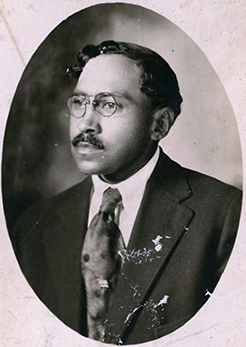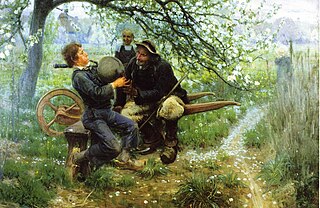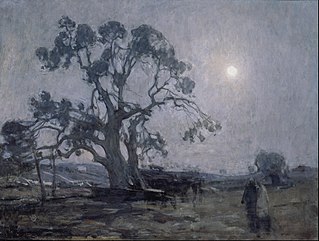
The Last Supper is a mural painting by the Italian High Renaissance artist Leonardo da Vinci, dated to c. 1495–1498, housed in the refectory of the Convent of Santa Maria delle Grazie in Milan, Italy. The painting represents the scene of the Last Supper of Jesus with the Twelve Apostles, as it is told in the Gospel of John – specifically the moment after Jesus announces that one of his apostles will betray him. Its handling of space, mastery of perspective, treatment of motion and complex display of human emotion has made it one of the Western world's most recognizable paintings and among Leonardo's most celebrated works. Some commentators consider it pivotal in inaugurating the transition into what is now termed the High Renaissance.

Thomas Hovenden was an Irish artist and teacher who spent much of his life in the United States. He painted realistic quiet family scenes and narrative subjects and often depicted African Americans.

Henry Ossawa Tanner was an American artist who spent much of his career in France. He became the first African-American painter to gain international acclaim. Tanner moved to Paris, France, in 1891 to study at the Académie Julian and gained acclaim in French artistic circles. In 1923, the French government elected Tanner chevalier of the Legion of Honor.

Chris Gollon (1953–2017) was a British artist.

Jesus at the home of Martha and Mary, in art usually called Christ in the House of Martha and Mary, and other variant names, is a Biblical episode in the life of Jesus in the New Testament which appears only in Luke's Gospel, immediately after the Parable of the Good Samaritan. Luke's account reads:

Magdalene with the Smoking Flame is a c. 1640 oil-on-canvas depiction of Mary Magdalene by French Baroque painter Georges de La Tour. Two versions of this painting exist, one in the Los Angeles County Museum of Art and the other in the Louvre Museum.

The Young Sabot Maker is an oil-on-canvas painting made by the American artist Henry Ossawa Tanner in 1895. The painting was accepted for the 1895 Paris Salon and was Tanner's second Salon-entered painting.

The Banjo Lesson is an 1893 oil painting by African-American artist Henry Ossawa Tanner. It depicts two African-Americans in a humble domestic setting: an old black man is teaching a young boy – possibly his grandson – to play the banjo.

The Thankful Poor is an 1894 genre painting by the African-American painter Henry Ossawa Tanner. It depicts two African Americans praying at a table, and shares common themes with Tanner's other paintings from the 1890s including The Banjo Lesson (1893) and The Young Sabot Maker (1895). The work is based on photographs Tanner had taken, and is influenced by his views on education and race, which were in turn derived from those of his father, Benjamin Tucker Tanner, and the African Methodist Episcopal Church. The painting is considered a milestone in African-American art, notably for its countering of racial stereotypes.

The Annunciation is an 1898 painting by the African-American painter Henry Ossawa Tanner. It depicts the biblical scene of the Annunciation, where the archangel Gabriel visits Mary to announce that she will give birth to Jesus. The painting is held by the Philadelphia Museum of Art.

Charles Franklin Moss (1878-1961) was an African American photographer and painter born in Winchester, Virginia. Moss' mother was born into slavery and his father was a mason. He showed interest in art early in his life and attended Cooper Union and the Pennsylvania Academy of the Fine Arts. He was the first African American member of the Professional Photographers of America and reportedly designed the Flag of Pennsylvania. Moss spent most of his life in Pennsylvania and his works were later featured in exhibitions. He operated photography studios in Carlisle and Harrisburg, and a painting studio in Pittsburgh. He and his second wife, Sarah Virginia Townson, raised a family of twelve children.

The Bagpipe Lesson is a painting by Henry Ossawa Tanner, completed in late 1893 and displayed at the World's Columbian Exposition and at the Pennsylvania Academy of the Fine Arts 63rd annual exhibition, held from December 18, 1893 to February 24, 1894. The painting was begun by Tanner during his first summer in France, during a trip to Brittany. He finished the work in Philadelphia.

Sarah Elizabeth Tanner was active as a missionary worker and a religious leader in the African Methodist Episcopal Church.

Woman From the West Indies is a painting by Henry Ossawa Tanner painted about 1891 in Brittany, France, during his first or second summer in France. The portrait is unsigned but is attributed to Tanner based on the way it was painted, compared to Tanner's known works from 1891-1893. Those examining the painting looked for patterns in the way the artist used color, the brush strokes, and the stylistic choices in how light itself is shown in the painting.

Salomé is a painting by Henry Ossawa Tanner, showing the princess Salome from the Bible, who danced before her stepfather Herod Antipas, and who demanded the head of John the Baptist as a reward for her performance. Tanner painted Salome as part of his Christian-themed paintings.

Abraham's Oak is a painting by Henry Ossawa Tanner, an American painter who lived in France, completed about 1905. While Tanner is well known today for two paintings in the United States, The Banjo Lesson and The Thankful Poor, both about African-American families, the bulk of his artwork, including some of his most iconic paintings, were concerned with exploring biblical subjects. Abraham's Oak was supposed to be a place where Abraham pitched his tent and built an altar to God, who had promised the Land of Canaan for him and his children, and where he was visited by an angel.

Flight into Egypt was a painting by Henry Ossawa Tanner, created in Paris about 1899 and displayed at the Carnegie Institute that year, along with Judas. The painting, a religious work, is an example of Tanner's symbolist paintings. The 1899 version was his first version of the painting.

The Resurrection of Lazarus is a painting by Henry Ossawa Tanner entered into the Paris Salon in 1897 and winning a third place medal. During his lifetime, this was the painting for which he was most known, his "masterwork". Since his death in 1937, secular tastes have pushed The Banjo Lesson to the top place in public esteem. The work was purchased by the French government for display in its Luxemburg museum. Today the painting is held by the Musée d'Orsay.

Nicodemus Visiting Christ is a painting by Henry Ossawa Tanner, made in Jerusalem in 1899 during the artist's second visit to what was then Palestine. The painting is biblical, featuring Nicodemus talking privately to Christ in the evening, and is an example of Tanner's nocturnal light paintings, in which the world is shown in night light.























